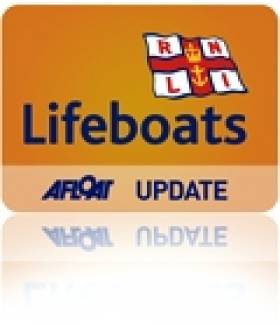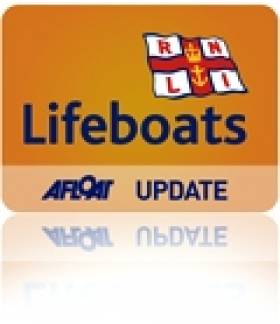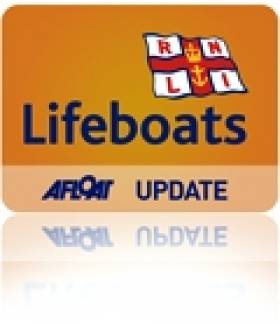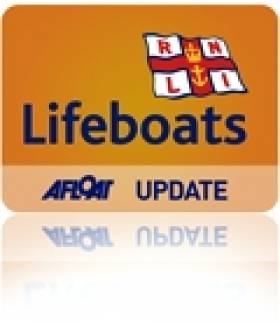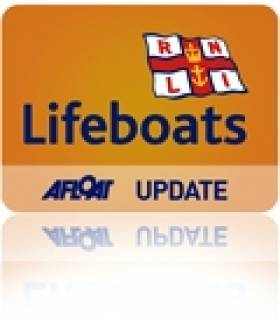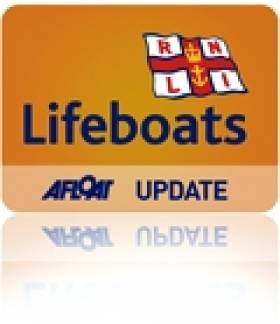Displaying items by tag: RNLI
Lifeboat Launches for Swimmer in Difficulty on Dublin Bay
A swimmer in difficulty was brought to safety at lunchtime today by the RNLI inshore lifeboat from Dun Laoghaire when a large swell caused problems at the popular 40-foot bathing-place at Sandycove, Co. Dublin.
The incident occurred when the female swimmer was unable to get ashore because of a breaking swell along the rocky shoreline. A male swimmer entered the water with a life-ring and supported the casualty while a member of the public telephoned 999 and asked for Marine Rescue.
The Irish Coastguard Marine Rescue Co-ordination Centre (MRCC) at Dublin received the alert and tasked the RNLI inshore lifeboat (ILB) at Dun Laoghaire shortly after 12.30pm. The volunteer crew of three launched seven
minutes later and recovered both swimmers from the water and landed them at Sandycove Harbour. A third swimmer was able to make his own way ashore and did not require assistance.
Weather conditions were fine with almost no wind but a sea-swell left-over from the near gale force winds last night combined with a flooding spring tide made swimming conditions more difficulty than usual. All three swimmers were reported to daily-regulars. None needed medical attention.
The ILB at Dun Laoghaire is an IB1-type that was recently placed on station and will be officially dedicated next year. The fully-inflatable boat is faster than its predecessor delivering a top speed of 25 knots and is ideal for reaching casualties close to rocks or shallow areas.
The crew of the ILB was Gary Hayes (Helmsman) Dan O'Sullivan and Sean Shanahan.
Related Safety posts
RNLI Lifeboats in Ireland
Safety News
Rescue News from RNLI Lifeboats in Ireland
Coast Guard News from Ireland
Water Safety News from Ireland
Marine Casualty Investigation Board News
Marine Warnings
Sea Songs and Shanties Make a Winning Combination
A wonderful weekend of maritime celebration took place in Rosses Point in August. It was the inaugural festival of Shanty and Seafaring organised by a local committee. The event took place over three days in the in the village which is steeped in seafaring history. As well as the singing readings and poetry, traditional Rosses Point events such as the "Go as you Please" and "Maugherow Cup" were hotly contested.
Many people from the village who lost their lives at sea were remembered in a special Mass and wreath laying ceremony at the "waiting on the shore" monument.
The total amount raised over the weekend through bucket collections, bbqs, and purchase of a specially commissioned CD by the local group Ashore for a Loaf, was a staggering €4434.00.
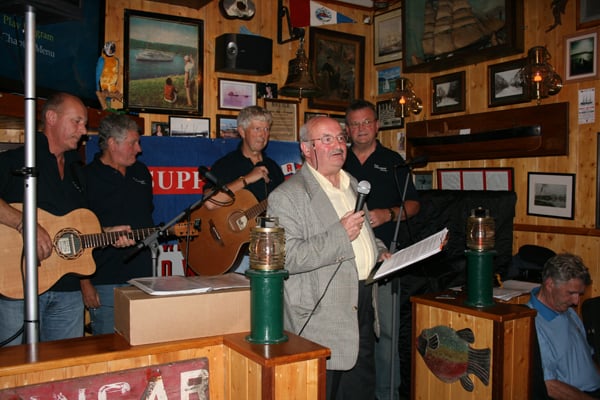
The Liverpool crew
The cheque was presented to the RNLI fundraising Chairman Pat Carter by Ann Mannion on behalf of the Shanty Festival Committee.In accepting the cheque Pat Carter congratulated the Shanty committee on a wonderful event and thanked them for their most generous donation to the RNLI. Pat Carter went onto thank the local people who as ever give very generously the RNLI Sligo Bay. The RNLI lifeboat service is funded entirely through voluntary donations.
The Committee have just announced that they will be holding an even bigger and better Shanty & Seafaring Festival in mid June 2011
Drifting Yacht Starts Shannon Search And Rescue Operation
A Shannon Estuary search and rescue operation was mounted early yesterday (Wednesday) after a yacht was reported adrift and at risk of entering a busy shipping and ferry lane.
The alarm was raised shortly after 8.30am after a member of the public spotted the yacht drifting off Labasheeda village in south west Clare. The person reported that there appeared to be nobody on board the vessel. The Irish Coast Guard Marine Rescue Centre at Valentia in Co Kerry was contacted and staff there alerted the RNLI Lifeboat based at Kilrush. The Shannon based Coast Guard rescue helicopter was also scrambled. More HERE from Pat Flynn in the Clare Herald.
Enniskillen and Baltimore Busiest Irish Lifeboats, Launching Five Times a Day in Summer
Preliminary figures* for summer 2010, issued today (22 September) by the Royal National Lifeboat Institution (RNLI), show the charity's Irish lifeboats launched on average five times every day during June, July and August.
RNLI lifeboats were requested to launch 450 times during June, July and August. The busiest station in Ireland was Enniskillen in Fermanagh with 29 launches followed by Baltimore in West Cork with 23 callouts. Fifty-four of those launches were in Dublin at lifeboat stations in Dun Laoghaire (22), Howth (20) and Skerries (12). Read more about the year's lifeboat rescues in 2010 HERE
The figures come on the back of a significant investment by the charity in the Irish lifeboat fleet. New inshore lifeboats have been put on service in Dun Laoghaire, Kilrush in Clare and Fenit in Kerry. These new lifeboats are fast, efficient and technically equipped to reach casualties faster and to provide increased cover around the coast.
Commenting on the RNLI summer lifeboat launches, RNLI Training Divisional Inspector, Owen Medland, said, 'It has been a busy Summer for Irish lifeboat crews. Over the course of those three months there have been a number of dramatic and challenging callouts for our volunteers. This summer RNLI Sea Safety volunteers have run a number of lifejacket clinics and flare demonstrations around the coast and at inland waterways to advise all water users on how to stay safe on the water.'
RNLI Operations Director, Michael Vlasto, added: 'The summer is always busy as more and more people opt to relax at the coast. The figures show that our volunteers are called on much more during this time and the fact they respond every time the pager goes off shows just how committed they are to saving lives at sea.
'Many of our lifeboat volunteers are also particularly busy at this time with their day jobs as many of them work in the tourism industry, so we are especially grateful to them in summer – and to their employers who allow them to stop work at the "bleep of a pager" to help others, and given the current economic climate for businesses this is a great contribution to the charity.'
Read more about the year's lifeboat rescues in 2010 HERE
Related Safety posts
RNLI Lifeboats in Ireland
Safety News
Rescue News from RNLI Lifeboats in Ireland
Coast Guard News from Ireland
Water Safety News from Ireland
Marine Casualty Investigation Board News
Marine Warnings
Fenit RNLI to name new D Class Lifeboat after Bangor Couple
A special naming and dedication ceremony will be held this Saturday (25 September 2010) at 3.00pm when volunteer lifeboat crew and supporters with Fenit RNLI lifeboat station in Kerry will gather to name their new IB1 lifeboat Bradley and Sonya. The lifeboat is being named in memory of Bradley and Sonya Burns, who were volunteers with Bangor RNLI lifeboat crew and who tragically died within 10 months of each other in 2006.
The lifeboat has been funded through an appeal set up by Bangor RNLI, who felt that the most appropriate way to honour the couple was to purchase a lifeboat and name it after them. This lifeboat has now been put on service in Fenit, County Kerry. It will be named by Mrs Mary Connolly and Mrs Eileen Savage, the mothers of Sonya and Bradley and twenty- five members of Bangor lifeboat crew will travel down from Northern Ireland to attend the ceremony.
The cost of the new D class lifeboat is €39,000. This type of lifeboat is built for launching quickly and operating close to shore. It is five metres in length and can reach a maximum speed of 25 knots. It can take two or three lifeboat crew and has room for five survivors. It will join Fenit's all weather Trent class lifeboat.
Sonya's sister Judy Connolly and Bangor RNLI helm Kyle Marshall will deliver the lifeboat into the care of Fenit lifeboat station.
All are welcome to attend.
Related Safety posts
RNLI Lifeboats in Ireland
Safety News
Rescue News from RNLI Lifeboats in Ireland
Coast Guard News from Ireland
Water Safety News from Ireland
Marine Casualty Investigation Board News
Marine Warnings
Swim from Ballycastle to Rathlin Island Completed
Local French teacher Gary Knox has completed his swim from Rathlin to Ballycastle for Portrush Lifeboat Station on the very day that the station was celebrating its 150th Anniversary.
Gerry Doran Chairman of the Ballycastle Fundraising Branch texted the station at the start of the race and then at the end to confirm that Gary had completed his amazing feat!
This information was then relayed to the people who had gathered in Portrush for the Service of Thanksgiving and Vellum presentation.
Shelley Pinkerton, Chairman of the Portrush Fundraising Branch said
'This is an example of the innovative ways that people come up with to raise funds for the RNLI. It's very fitting that Gary completed the swim on the very day we are gathered to celebrate Portrush Lifeboat Station 150 years of saving lives at sea'
Gary who was not wearing wetsuit swam approximately 7 miles in 2 hours 55 minutes. The swim was for the RNLI and in memory of his friend and training partner, Ciaran McGinn who completed the endurance swim in 2007 and raised funds for his charity, Ballycastle RNLI.
Gary was accompanied by Portrush kayakers who followed the rib and provided him with energy drink every hour. In accordance with ILDSA rules, Gary was not permitted to touch the boat or kayak. Donations can still be made online at justgiving.com/gary-knox and there are collection boxes in the shops along the prom in Ballycastle.
Gary would like to thank Alan Wilson of Aquasports for providing boat cover, John Morton for advice and guidance, members of the Ballycastle Fundraising Branch and others for their assistance in organising the event.
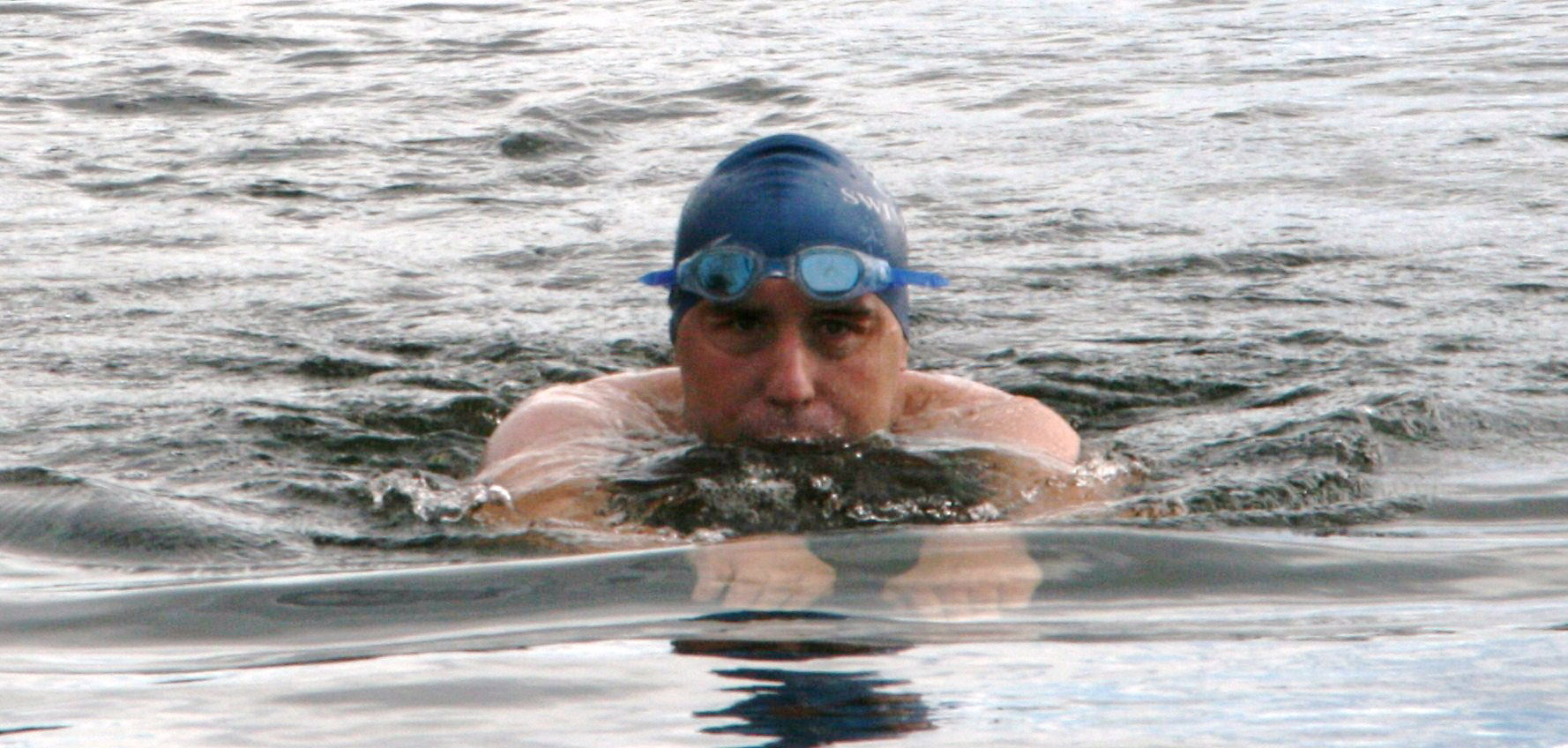
Gary nears the finish line
Portrush Lifeboat Station Celebrates 150 years
A service of thanksgiving marked the start of a year of events to celebrate Portrush Lifeboat Station's 150 years of saving lives at sea. The volunteer lifeboat crewmembers, fundraisers and supporters held a service in Portrush with the Inshore Boat 'The Ken and Mary' making her last appearance as a Portrush Lifeboat.
The event was held exactly 150 years after Laura, the Countess of Antrim helped establish the Lifeboat Station on the North Coast.
The service started with James Heaney, Chairman of Portrush Lifeboat Station giving a brief history of the station. Michael Hassan and Shay Reynolds sang a song that Michael had composed for the station called 'You're never on your own' and Ballywillan Band played the crews favourite hymns. By coincidence the band unveiled their new crest which includes a rope ring, a nod to their close relationship with the lifeboat station.
.
Father Sheehan, Reverend Simpson, Pastor Todd and Rev Kirkpatrick all did readings and prayers reflecting the dedication of the volunteer crews to saving lives at sea. Karl O'Neill one of the youngest crew members read the 'Lifeboat Prayer'
After the service John D Coyle MEconSc Chairman RNLI Ireland Council handed over a vellum to Robin Cardwell, Lifeboat Operations Manager. Mr Coyle praised the work of the crews and teams attached to the station and congratulated everyone on reaching this milestone. He reflected on the advances in technology which has made the lifeboats ever more sophisticated, but how the RNLI still depend on volunteers to crew them.
Robin accepted the vellum and thanked everyone for attending especially crew families who wait at home when the crews are out at sea. He thanked the crews for their dedication and commitment to training both on station and at Poole. He said that the vellum would be hung with pride at the station. Coxswain Willie McAuley presented Mr Coyle with a signed book on the history of the station and Shelley Pinkerton, Chairman of the Fundraising Team, proposed the vote of thanks to Mr Coyle, and reminded everyone why fundraising was so important to the RNLI.
After the formal proceedings ended Limavady Big Band sound played a medley of swing sounds which entertained everyone while friends past and present reminisced.
Related Safety posts
RNLI Lifeboats in Ireland
Safety News
Rescue News from RNLI Lifeboats in Ireland
Coast Guard News from Ireland
Water Safety News from Ireland
Marine Casualty Investigation Board News
Marine Warnings
Free Lifejacket Check in Dun Laoghaire Today
With the summer boating season coming to a close, the RNLI’s Sea Safety team is back in Dun Laoghaire this morning and people who use the water are being invited to get their lifejackets checked out for free and find out more about this vital piece of boating kit.
It's an ideal opportunity to get the jackets checked before putting them away for the winter or indeed before the start of the different winter series on the Bay.
The RNLI carried out a similar service during the summer and on that occasion Over 90% of lifejackets tested at Ireland's two biggest sailing centres failed the simple checks.
From 91 jackets tested in Cork and Dublin, 83 failed the free inspection.
The annual Lifejacket check service carried out by the institute was only taken up by 40 sailors from an estimated 1,000 competing crews at Cork week. 35 failed the test.
The RNLI lifejacket clinic took place yesterday at Dun Laoghaire marina and takes place again today.
The RNLI’s lifejacket campaign, first launched in June 2007, aims to encourage all who go to sea in their leisure time to always put their lifejackets on when going to sea, and then decide when (if at all) to take it off.
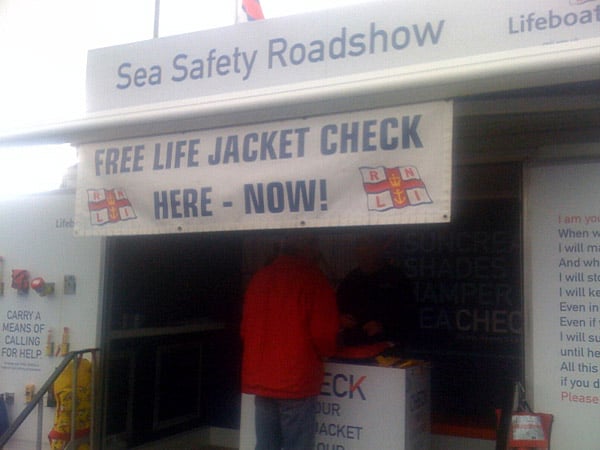
RNLI Divisional Sea Safety Manager, Nicola Davies, explains:
‘A lifejacket is useless unless worn, if it is worn incorrectly or if it is not in full working order. It’s much safer to get into the habit of wearing a lifejacket at all times when afloat, because it means you’ll be familiar with your particular lifejacket and how to operate it should an emergency situation unfold. In the summer months when boat owners may take family and friends who don’t often go afloat, it’s even more crucial to ensure that all on board, including babies and children, are wearing a well-fitted lifejacket.
‘A correctly fitting lifejacket will keep you afloat so that, should you end up in the water, you have time to overcome the initial shock and you can begin to think about survival. It will also keep your airways clear of the water, which is absolutely crucial because it only takes just a cup full of water in the lungs to make survival difficult and just over a litre to drown. A lifejacket also buys you time, this will allow for the search and rescue services to come to your aid. Our advice is not meant to spoil the fun of water users, but it is founded on the years of experience of RNLI lifeboat crew who know how unpredictable the weather can be and how quickly things can go wrong at sea.’
Lifejackets should not only be worn, but they need regular maintenance checks too. They should be stored in a dry, well-aired area when not in use. RNLI Sea Safety managers and volunteers around the coast of the UK and Ireland found that almost 35 per cent of lifejackets they’ve looked at during RNLI Sea Checks would, in their opinion, fail to operate.
Related Safety posts
RNLI Lifeboats in Ireland
Safety News
Rescue News from RNLI Lifeboats in Ireland
Coast Guard News from Ireland
Water Safety News from Ireland
Marine Casualty Investigation Board News
Marine Warnings
Bangor Lifeboat Crew to Receive Freedom of the Borough
The Atlantic 85 type lifeboat. the Jessie Hillyard. based in Bangor Harbour has two Yamaha 4-stroke engines giving a top speed of 35 knots. It features state of the art radar, chart plotter VHF radio and radio direction finding technology to enhance its lifesaving capabilities. Volunteer crew at Bangor take pride in a launch time of under four minutes from when their rescue pagers are activated.
Everyone connected with RNLI Bangor Lifeboat - the crew, station management, fundraisers and helpers - are all volunteers, giving freely of their time, braving all weathers, 24 hours a day, 365 days a year to help save life at sea.
Bangor's Lifeboat Operations Manager Kevin Byers also a volunteer is looking forward to receiving North Down Borough Councils highest award honouring the work of RNLI Bangor Lifeboat. He said
'We wish to publicly thank North Down Borough Council for their continued support and for honouring RNLI Bangor Lifeboat with this prestigious award' he added.
'It is a truly fitting tribute to the huge commitment and dedication of the Bangor volunteer crew and station personnel both past and present who have devoted so much of their time and effort to lifesaving at sea'
Related Safety posts
RNLI Lifeboats in Ireland
Safety News
Rescue News from RNLI Lifeboats in Ireland
Coast Guard News from Ireland
Water Safety News from Ireland
Marine Casualty Investigation Board News
Marine Warnings
Lifeboat Assists Vessel with Engine Failure on Lough Derg
At 7.30pm tonight Lough RNLI Derg lifeboat towed a vessel to safety after it suffered engine failure. 15 minutes earlier the lifeboat was requested to launch to assist three persons in distress on board the 38ft motor cruiser. The lifeboat with helm Peter Clarke, Eleanor Hooker and Colin Knight on board, launched with into winds west north-west, Force 5, gusting 6 with rough seas. Visibility was initially good with fading light.
The lifeboat located the vessel in Youghal Bay, close to Ryan's Point, and was alongside at 19.35hrs. All passengers were safe and unharmed. They were wearing their lifejackets. The vessel had dropped anchor to prevent being itself being grounded, but the anchor was not holding and the vessel was rolling side-on to steep waves. Once a tow was set up, an RNLI crew member weighed anchor and the vessel and her passengers were taken to the safety of the public harbour in Garrykennedy.
The lifeboat returned to station and was ready for service again at 20.30hrs
Related Safety posts
RNLI Lifeboats in Ireland
Safety News
Rescue News from RNLI Lifeboats in Ireland
Coast Guard News from Ireland
Water Safety News from Ireland
Marine Casualty Investigation Board News
Marine Warnings


























